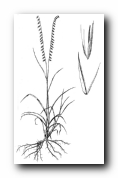
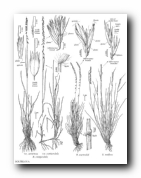
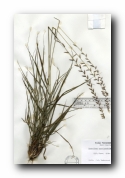
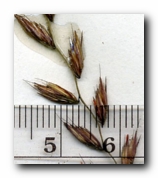
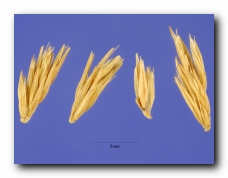
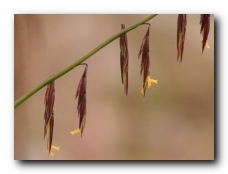
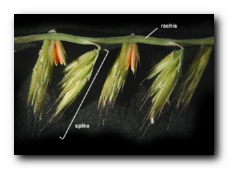
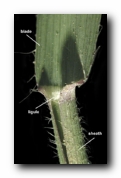
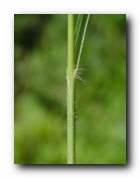
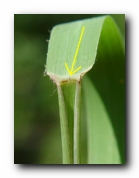
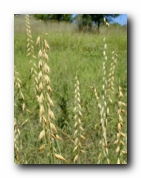

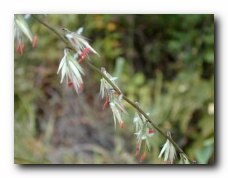
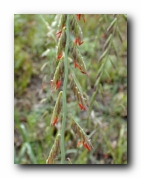
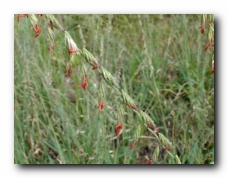
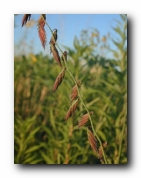
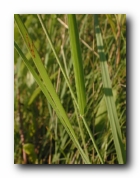
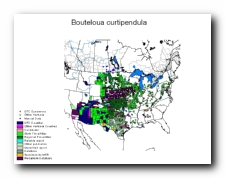
40" Rows: Broadcast:
1.5 pounds pure live seed per acre
4.5 pounds pure live seed per acre
Loam:
Clay:
Moderate
High
High
Habit: Tufted perennial, with strong, short, scaly rhizomes. Culms: 50-100 cm. tall, erect, tufted, smooth and glabrous. Blades: Numerous, 5-15 (25) cm. long, 2-4 mm. wide, flat or involute and setaceous toward the end, scabrous above and on the margins, sometimes more or less hairy and sparingly papillose on the margins, especially near the base. Sheaths: Usually shorter than the internodes, loose, striate, glabrous or the lower densely papillose-hairy, the throat often pilose and papillose-hispid. Ligule: Ciliate-fringed, very short. Inflorescence: Panicle racemose, 7-40 cm. long, 1-sided, with an angled or flattened axis, of many (20-60) spikes, 6-15 mm. long, on short, flattened, puberulent peduncles, approximate or distant, spreading or pendulous and mostly twisted to one side, the spikes falling entire. Spikelets: 4-12, divergent, 6-10 mm. long, 1 perfect flower. Glumes: Scabrous especially on the keels, first narrow, acute, 4-5 mm. long, the upper broader, about 7 mm. long, of two very delicate awns, or almost a full-formed lemma with rather long awns. Lemmas: Of fertile floret 5-6 mm. long, oblong, smooth or slightly scabrous toward the apex, the 3 nerves extended into 3 short awns. Palea: About the length of the lemma, acuminate, bidentate, the 2 keels scabrous. Rudiment: Reduced to a minute scale with a delicate scabrous awn, and a rudimentary palea consisting of two very delicate awns, or almost a full-formed lemma with rather long awns. Habitat: Plains, prairies and rocky hills. July-September. Use: An important native grass of the prairie. Synonyms: Bouteloua curtipendula (Michx.) Torr. var. caespitosa Gould & Kapadia Bouteloua curtipendula (Michx.) Torr. var. curtipendula
Special Notes:
Sideoats Grama (Bouteloua curtipendula) Information #1
Sideoats Grama (Bouteloua curtipendula) Information #2
Sideoats Grama (Bouteloua curtipendula) Information #3
Regional Adaptation |
||||||||||||||||||
Variety |
Coast Saline Prairie |
Coast Prairie |
East Texas Timberlands |
Claypan Area |
Blackland Prairie |
East Cross Timbers |
West Cross Timbers |
Grand Prairie |
North Central Prairies |
Central Basin |
Edwards Plateau |
Northern Rio Grande Plain |
Western Rio Grande Plain |
Central Rio Grande Plain |
Lower Rio Grande Valley |
Rolling Plains |
High Plains |
Trans-Pecos |
| Sideoats | X |
X |
X |
X |
X |
X |
X |
X |
X |
X |
X |
X |
X |
X |
||||
| Haskell | X |
X |
X |
X |
X |
X |
X |
X |
X |
X |
X |
X |
X |
X |
||||
| Premier | X |
X |
X |
X |
||||||||||||||
| El Reno | X |
X |
X |
X |
X |
X |
X |
|||||||||||
| Niner | X |
X |
X |
X |
||||||||||||||
| Vaughn | X |
|||||||||||||||||
| Uvalde | X |
X |
X |
X |
||||||||||||||